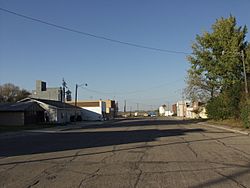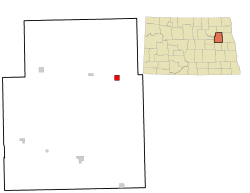Petersburg, North Dakota facts for kids
Quick facts for kids
Petersburg, North Dakota
|
|
|---|---|

Looking down a street in Petersburg
|
|

Location of Petersburg, North Dakota
|
|
| Country | United States |
| State | North Dakota |
| County | Nelson |
| Founded | 1884 |
| Area | |
| • Total | 1.04 sq mi (2.69 km2) |
| • Land | 1.03 sq mi (2.66 km2) |
| • Water | 0.01 sq mi (0.03 km2) |
| Elevation | 1,526 ft (465 m) |
| Population
(2020)
|
|
| • Total | 162 |
| • Estimate
(2022)
|
160 |
| • Density | 157.59/sq mi (60.82/km2) |
| Time zone | UTC-6 (Central (CST)) |
| • Summer (DST) | UTC-5 (CDT) |
| ZIP code |
58272
|
| Area code(s) | 701 |
| FIPS code | 38-61860 |
| GNIS feature ID | 1036218 |
Petersburg is a small city in Nelson County, North Dakota, United States. As of the 2020 census, 162 people lived there. It's a quiet place with a rich history.
Contents
History of Petersburg
Petersburg was started in 1884. Two men, Martin N. Johnson and Levi H. Peterson, owned land next to the Great Northern Railway. They decided to create a town there.
To choose the town's name, they flipped a coin. Peterson won the coin toss. He chose the name Petersburg, probably naming it after himself.
Geography and Climate
Where is Petersburg?
Petersburg is located in North Dakota. The United States Census Bureau says the city covers about 1.04 square miles (2.69 square kilometers). Most of this area is land, with a very small part being water.
What is the Climate Like?
Petersburg has a climate with big changes in temperature throughout the year. Summers are warm to hot, and sometimes humid. Winters are very cold. This type of weather is known as a humid continental climate.
| Climate data for Petersburg 2 N, North Dakota (1991–2020 normals, extremes 1944–present) | |||||||||||||
|---|---|---|---|---|---|---|---|---|---|---|---|---|---|
| Month | Jan | Feb | Mar | Apr | May | Jun | Jul | Aug | Sep | Oct | Nov | Dec | Year |
| Record high °F (°C) | 50 (10) |
62 (17) |
79 (26) |
98 (37) |
96 (36) |
103 (39) |
100 (38) |
102 (39) |
102 (39) |
92 (33) |
75 (24) |
57 (14) |
103 (39) |
| Mean daily maximum °F (°C) | 13.7 (−10.2) |
18.6 (−7.4) |
31.3 (−0.4) |
49.7 (9.8) |
64.9 (18.3) |
74.3 (23.5) |
78.9 (26.1) |
78.3 (25.7) |
68.9 (20.5) |
52.3 (11.3) |
34.0 (1.1) |
19.9 (−6.7) |
48.7 (9.3) |
| Daily mean °F (°C) | 4.8 (−15.1) |
9.0 (−12.8) |
22.2 (−5.4) |
39.0 (3.9) |
53.4 (11.9) |
63.7 (17.6) |
68.2 (20.1) |
66.6 (19.2) |
57.0 (13.9) |
42.0 (5.6) |
25.6 (−3.6) |
11.8 (−11.2) |
38.6 (3.7) |
| Mean daily minimum °F (°C) | −4.2 (−20.1) |
−0.7 (−18.2) |
13.2 (−10.4) |
28.4 (−2.0) |
41.9 (5.5) |
53.1 (11.7) |
57.5 (14.2) |
54.9 (12.7) |
45.2 (7.3) |
31.7 (−0.2) |
17.1 (−8.3) |
3.6 (−15.8) |
28.5 (−1.9) |
| Record low °F (°C) | −42 (−41) |
−44 (−42) |
−34 (−37) |
−12 (−24) |
5 (−15) |
28 (−2) |
30 (−1) |
25 (−4) |
15 (−9) |
−1 (−18) |
−25 (−32) |
−39 (−39) |
−44 (−42) |
| Average precipitation inches (mm) | 0.44 (11) |
0.45 (11) |
0.50 (13) |
0.94 (24) |
2.79 (71) |
3.84 (98) |
3.61 (92) |
2.51 (64) |
2.12 (54) |
1.66 (42) |
0.73 (19) |
0.64 (16) |
20.23 (514) |
| Average snowfall inches (cm) | 6.3 (16) |
7.7 (20) |
7.7 (20) |
2.2 (5.6) |
0.6 (1.5) |
0.0 (0.0) |
0.0 (0.0) |
0.0 (0.0) |
0.0 (0.0) |
2.2 (5.6) |
4.9 (12) |
10.9 (28) |
42.5 (108) |
| Average precipitation days (≥ 0.01 in) | 3.5 | 3.6 | 3.4 | 4.6 | 8.8 | 9.8 | 8.7 | 7.4 | 6.5 | 6.5 | 4.0 | 3.9 | 70.7 |
| Average snowy days (≥ 0.1 in) | 3.3 | 3.5 | 3.2 | 1.0 | 0.2 | 0.0 | 0.0 | 0.0 | 0.0 | 0.9 | 3.2 | 3.8 | 19.1 |
| Source: NOAA | |||||||||||||
People of Petersburg
Population Changes Over Time
Petersburg's population has changed over the years. Here's how it looked at different times:
| Historical population | |||
|---|---|---|---|
| Census | Pop. | %± | |
| 1910 | 353 | — | |
| 1920 | 367 | 4.0% | |
| 1930 | 310 | −15.5% | |
| 1940 | 285 | −8.1% | |
| 1950 | 318 | 11.6% | |
| 1960 | 272 | −14.5% | |
| 1970 | 266 | −2.2% | |
| 1980 | 230 | −13.5% | |
| 1990 | 219 | −4.8% | |
| 2000 | 195 | −11.0% | |
| 2010 | 192 | −1.5% | |
| 2020 | 162 | −15.6% | |
| 2022 (est.) | 160 | −16.7% | |
| U.S. Decennial Census 2020 Census |
|||
Petersburg in 2010
In 2010, the census counted 192 people living in Petersburg. There were 78 households, which are groups of people living together. About 58 of these were families.
The average age of people in Petersburg was 41 years old. About 24% of the residents were under 18. About 18.8% were 65 years or older. The city had slightly more females (51%) than males (49%).
Transportation Around Petersburg
The Amtrak train called the Empire Builder goes through Petersburg. This train travels between Seattle/Portland and Chicago. However, the train does not stop in Petersburg. The closest train station is in Devils Lake, which is about 43 miles away.
Notable People from Petersburg
Petersburg is home to some important people:
- Martin N. Johnson: He was a U.S. Congressman and later a Senator for North Dakota. He is buried in Petersburg.
- Scott Meyer: He is a member of the North Dakota Senate, which is part of the state's government.
See also
 In Spanish: Petersburg (Dakota del Norte) para niños
In Spanish: Petersburg (Dakota del Norte) para niños

